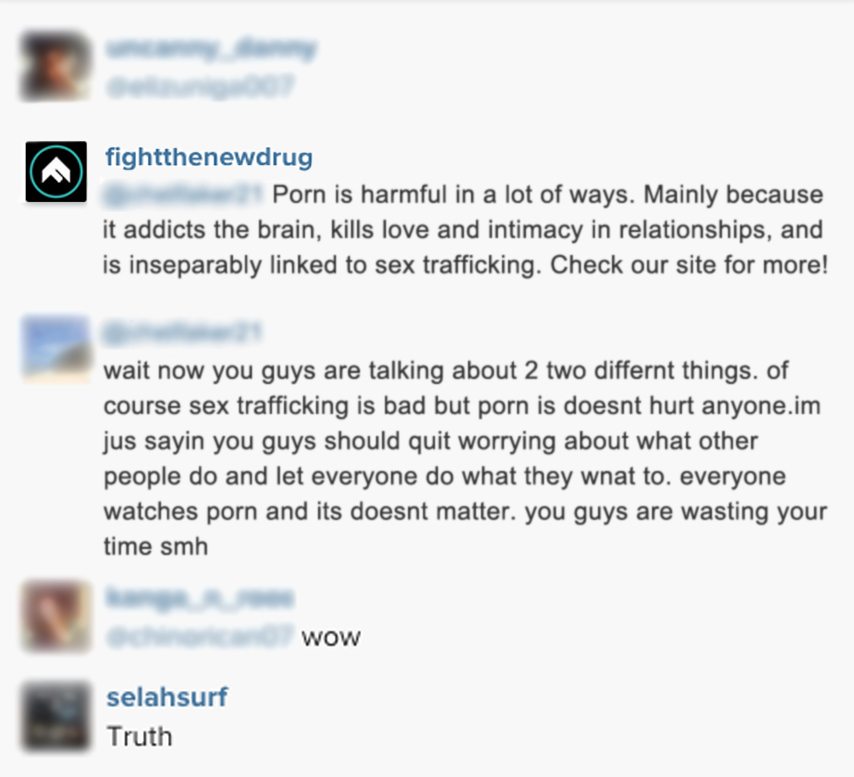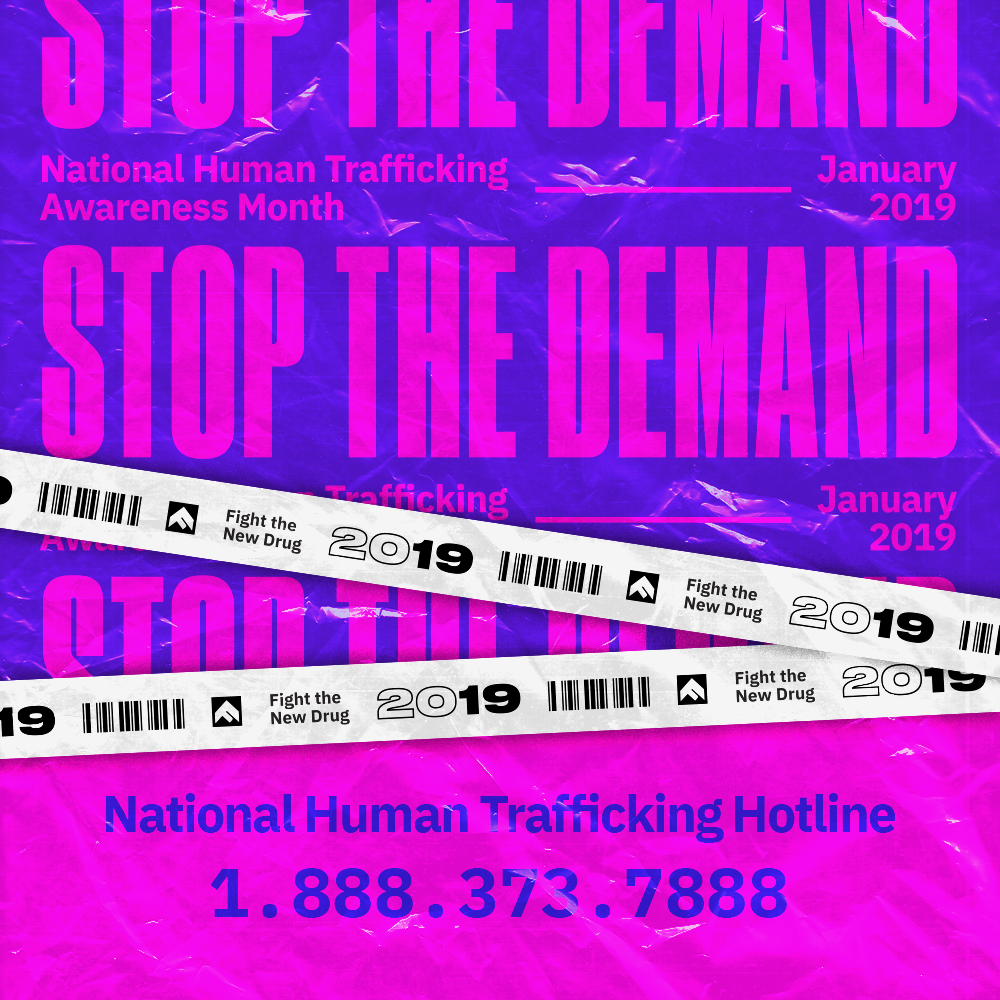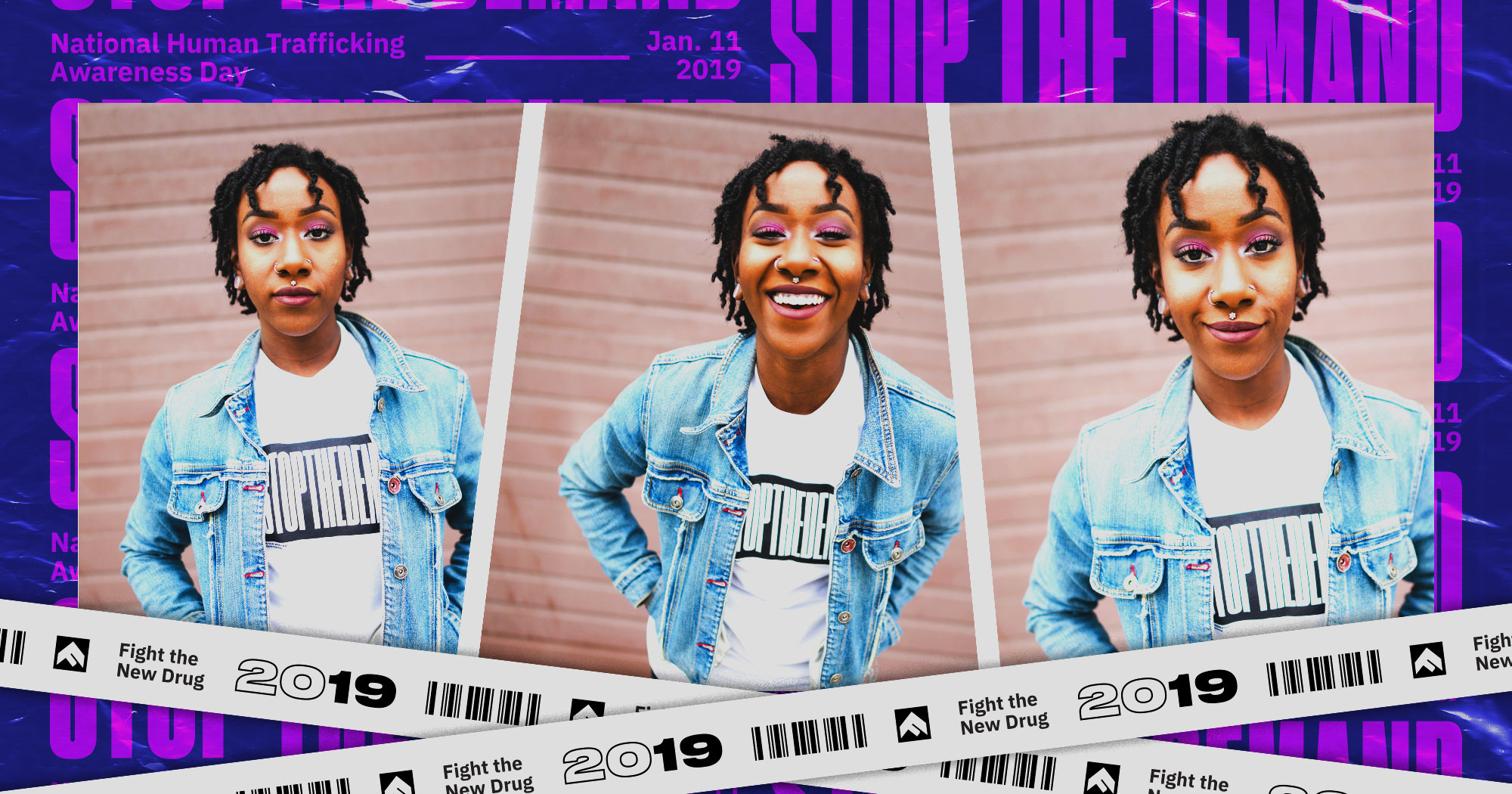Science and research are showing that porn isn’t only harmful to those who watch it, it’s also harmful to those who create it. And in too many cases, these people are forced, coerced, or tricked into having commercial sex on camera.
We can’t tell you how many people scoff when we tell them that one of the negative aspects of pornography is how it fuels the demand for sexual exploitation and human sex trafficking. Many have the same attitude as one Instagram user who recently commented on one of our photos, asking us why we were against porn. When we responded that one of the reasons we fight against porn was because of its inseparable link to sex trafficking, this was their reply:

Unfortunately, there are many in society that are blind to the link between porn and sex trafficking. They think that the porn industry and sex trafficking industry are two completely separate issues, one being legitimate and the latter being illegal activity that only happens in far away places halfway around the world. Not so.
How are porn and sex trafficking connected?
There are all kinds of connections, big and small, between pornography and sex trafficking. There are incidental connections, like the fact that exposure to pornography has been shown to make consumers less compassionate toward victims of sexual violence and exploitation.[2] (See How Consuming Porn Can Lead To Violence.)
There are “supply-and-demand” connections: the simple fact that pornography—especially when viewing habits and fantasies involve violence or other fetishes—increases the demand for sex trafficking, as more and more consumers want to act out what they see.
There is the “training manual” connection: the well-documented fact that porn directly informs what goes on in trafficking. Traffickers and sex buyers get ideas from porn, and then make their victims watch as a way of showing them what they’ll be expected to do, so that the violent fantasy concocted by some porn director and his or her actors becomes the reality for some trafficking victim. [3]
Related: How Porn Fuels Sex Trafficking
And then there is the risk factor connection: the fact that, along with poverty and substance abuse, a child growing up in a home where pornography is regularly consumed is far more likely to be trafficked at some point in his or her life. [4]
But what’s the biggest, most surprising connection between pornography and trafficking? It’s this: they’re often the same thing.
We can spend hours and hours pointing out these cause-and-effect, symbiotic relationships between trafficking and porn. Those connections are real, and that’s an important conversation to have. But let’s not allow that to entrench the idea that porn and sex trafficking are always separate. Far more often than people realize, they’re not.
Knowledge is power, and being aware of the facts is an important step in decreasing the demand for porn and helping to eliminate sex trafficking.
Porn and sexual exploitation of children
Every day, children are filmed while they’re sexually abused and the content is then distributed worldwide. It’s a booming underground industry that continues to grow year after year. This is a form of digital sex slavery that entraps countless innocent children and keeps them captive by those looking to make a profit. Research shows that child sexual abuse content is a top online concern and at least 1.5 million adults stumble upon it on a regular basis. Some people, however, intentionally go looking for it.
In this powerful new video by International Justice Mission, one of the most heinous crimes and most devastating forms of slavery is documented. It’s real. It hurts thousands of children. And all it takes is wifi.
Unfortunately, child pornography has become more prevalent than we ever could have imagined; the people who actually get caught for possessing it are just the tip of the iceberg.
The Internet Watch Foundation recently reported their research on child sex abuse live-streaming which reveals 98% of victims are 13 or under.
According to the National Society for the Prevention of Cruelty to Children, every week, there are over 20,000 images of child pornography posted on the web. Furthermore, U.S Customs Services estimates that illegal child pornography is offered by approximately 100,000 websites. According to a 2009 United Nations Human Rights Council Report, the production and distribution of child pornography has an estimated value of between $3 billion and $20 billion—its reach has certainly grown in the last 10 years since that report.
It’s a booming business, and its effects are spreading quickly.
Just a few years ago in Toronto, Canada, nearly 400 children were rescued and 348 adults arrested following a massive international child pornography investigation that took down a $4 million child porn production empire that distributed its illegal content to over 50 countries worldwide.
Police seized over 45 terabytes of child porn in the bust. What was most alarming about this case? Many of the arrests were of people who worked with or closely interacted with children. Among those arrested were 40 school teachers, nine doctors and nurses, six law enforcement personnel, nine pastors and priests, and three foster parents.
How can I help?
There are many ways that you can help the fight against sex trafficking. Below are just some of the ways you can make a real difference right where you’re standing:
Know how to identify a victim of trafficking
Recently, a northern California Uber driver helped rescue a teenage girl who was being trafficked and prostituted by two female pimps. Just by being aware and knowing what to look for in language and behavior, he was able to recognize the situation that was taking place in his back seat and alert the authorities who then arrested the pimps and returned the girl to her family. There’s no doubt about it: his actions saved the 16-year-old’s life.
In a similar scenario, a postal service worker was able to rescue a girl who ran away from her traffickers.
It’s a sad fact that sex trafficking takes place in nearly every country. While there are horrible situations in which young girls’ virginity is sold off by their poverty-stricken parents in Cambodia, the reality is that western countries are by no means immune to the trade. Runaways, girls who have fallen for the wrong guy, and naive people who have traveled from another country on the promise of a legitimate job can get trapped in sexual expliotation rings anywhere, and their images and videos sold online.
Click here for more information on what to look for with possible trafficking victims.
If you’re in the United States, the phone number to the National Human Trafficking Hotline is 1-888-373-7888.
Download the new app that lets you fight human trafficking while you travel
The hotel industry is a huge battleground in the fight against sex trafficking. Now, you can help the cause every time you travel in one simple way by using an app called TraffickCam, available for iOS and Android. The app is targeted toward travelers who book hotel rooms and snapping a picture inside your room could help protect children and rescue sex trafficking victims across the globe.
TraffickCam is intended to make the search for young trafficking victims strikingly faster for law enforcement. App users can snap photos of their hotel rooms before unpacking, then upload the photos to the app. The growing collection of photos feeds a national database that has a search tool enhanced by cutting-edge computer image analysis created by researchers at Washington U.
Likewise, law enforcement officers feed the database photos from escort advertisements that appear to be of minors taken in hotel rooms. Complex search algorithms then analyze the hotel decor to find a match. App photos containing rug patterns and textures, drapery designs, lampshades, wall art, bed linens and specific furniture provide thousands of data points for the computer to match with a specific hotel or chain.

This program could save detectives days and weeks of sorting photos and speed their response to a location of a pimp or a victim, said Molly Hackett, one of the three local women who came up with the idea of collecting hotel photos.
How effective is it? One of its inventors, Abby Stylianou, a Metro High School graduate with a passion for computer imaging analysis and social justice, said test trials are highly encouraging. About 85 percent of the time, the computer algorithm is able to deliver a hotel match in the first 20 photos it returns from the search.
Related: “TraffickCam”: This New App Helps You Fight Sex Trafficking While You Travel
Success ultimately hinges on how many people use the app to send photos to the database, said Hackett, a principal at Nix Conference and Meeting Management in Maplewood.
“There aren’t many opportunities for anybody on any given day to make a difference in sex trafficking, but with this app, you really can,” she said.

This is what a user-submitted photo would look like, sent into the app and analyzed for further details. Simply taking a photo like this could save someone from further sex trafficking. How cool is that?
Find a local organization to see how you can help
We are all about raising awareness on this important topic, but there are other organizations that are working tirelessly with boots on the ground efforts that need your help. One of the best ways to get involved in this fight is to find a local organization that is working to make a difference right in your community, and also on a worldwide scale.
To find a group in your city, search online to find out how you can get involved. Together, our voices are loud.

Your Support Matters Now More Than Ever
Most kids today are exposed to porn by the age of 12. By the time they’re teenagers, 75% of boys and 70% of girls have already viewed itRobb, M.B., & Mann, S. (2023). Teens and pornography. San Francisco, CA: Common Sense.Copy —often before they’ve had a single healthy conversation about it.
Even more concerning: over half of boys and nearly 40% of girls believe porn is a realistic depiction of sexMartellozzo, E., Monaghan, A., Adler, J. R., Davidson, J., Leyva, R., & Horvath, M. A. H. (2016). “I wasn’t sure it was normal to watch it”: A quantitative and qualitative examination of the impact of online pornography on the values, attitudes, beliefs and behaviours of children and young people. Middlesex University, NSPCC, & Office of the Children’s Commissioner.Copy . And among teens who have seen porn, more than 79% of teens use it to learn how to have sexRobb, M.B., & Mann, S. (2023). Teens and pornography. San Francisco, CA: Common Sense.Copy . That means millions of young people are getting sex ed from violent, degrading content, which becomes their baseline understanding of intimacy. Out of the most popular porn, 33%-88% of videos contain physical aggression and nonconsensual violence-related themesFritz, N., Malic, V., Paul, B., & Zhou, Y. (2020). A descriptive analysis of the types, targets, and relative frequency of aggression in mainstream pornography. Archives of Sexual Behavior, 49(8), 3041-3053. doi:10.1007/s10508-020-01773-0Copy Bridges et al., 2010, “Aggression and Sexual Behavior in Best-Selling Pornography Videos: A Content Analysis,” Violence Against Women.Copy .
From increasing rates of loneliness, depression, and self-doubt, to distorted views of sex, reduced relationship satisfaction, and riskier sexual behavior among teens, porn is impacting individuals, relationships, and society worldwideFight the New Drug. (2024, May). Get the Facts (Series of web articles). Fight the New Drug.Copy .
This is why Fight the New Drug exists—but we can’t do it without you.
Your donation directly fuels the creation of new educational resources, including our awareness-raising videos, podcasts, research-driven articles, engaging school presentations, and digital tools that reach youth where they are: online and in school. It equips individuals, parents, educators, and youth with trustworthy resources to start the conversation.
Will you join us? We’re grateful for whatever you can give—but a recurring donation makes the biggest difference. Every dollar directly supports our vital work, and every individual we reach decreases sexual exploitation. Let’s fight for real love:

